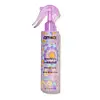What's inside
What's inside
 Benefits
Benefits

 Concerns
Concerns

 Ingredients Side-by-side
Ingredients Side-by-side

Water
Skin ConditioningOctylacrylamide/Acrylates/Butylaminoethyl Methacrylate Copolymer
Propylene Glycol
HumectantPEG-40 Hydrogenated Castor Oil
EmulsifyingHippophae Rhamnoides Fruit/Seed Oil
AntimicrobialPanthenol
Skin ConditioningGlycerin
HumectantAminomethyl Propanol
BufferingPolysorbate 20
EmulsifyingPEG-12 Dimethicone
Skin ConditioningPPG-12 Dimethicone
Skin ConditioningPhenoxyethanol
PreservativePotassium Sorbate
PreservativeBenzyl Alcohol
PerfumingParfum
MaskingBenzyl Benzoate
AntimicrobialHydroxycitronellal
PerfumingLimonene
PerfumingCitronellol
PerfumingCoumarin
PerfumingWater, Octylacrylamide/Acrylates/Butylaminoethyl Methacrylate Copolymer, Propylene Glycol, PEG-40 Hydrogenated Castor Oil, Hippophae Rhamnoides Fruit/Seed Oil, Panthenol, Glycerin, Aminomethyl Propanol, Polysorbate 20, PEG-12 Dimethicone, PPG-12 Dimethicone, Phenoxyethanol, Potassium Sorbate, Benzyl Alcohol, Parfum, Benzyl Benzoate, Hydroxycitronellal, Limonene, Citronellol, Coumarin
Crambe Abyssinica Seed Oil Phytosterol Esters
EmulsifyingHydrogenated Ethylhexyl Olivate
EmollientSaccharomyces Cerevisiae Extract
Skin ConditioningGlycerin
HumectantSqualane
EmollientHydrogenated Olive Oil Unsaponifiables
EmollientBrassica Oleracea Acephala Leaf Extract
HumectantCucurbita Pepo Seed Extract
Skin ConditioningLentinus Edodes Extract
Skin ConditioningOpuntia Tuna Fruit Extract
Skin ConditioningPsidium Guajava Fruit Extract
AstringentRibes Nigrum Fruit Extract
AstringentC20-22 Alkyl Phosphate
EmulsifyingC20-22 Alcohols
Emulsion StabilisingPolysorbate 60
EmulsifyingPolyester-11
Skin ConditioningHydroxyethyl Acrylate/Sodium Acryloyldimethyl Taurate Copolymer
Emulsion StabilisingEthylhexylglycerin
Skin ConditioningCitric Acid
BufferingDisodium EDTA
Leuconostoc/Radish Root Ferment Filtrate
AntimicrobialPotassium Sorbate
PreservativeAminomethyl Propanol
BufferingSodium Hydroxide
BufferingPhenoxyethanol
PreservativeSodium Benzoate
MaskingParfum
MaskingLinalool
PerfumingLimonene
PerfumingGeraniol
PerfumingCrambe Abyssinica Seed Oil Phytosterol Esters, Hydrogenated Ethylhexyl Olivate, Saccharomyces Cerevisiae Extract, Glycerin, Squalane, Hydrogenated Olive Oil Unsaponifiables, Brassica Oleracea Acephala Leaf Extract, Cucurbita Pepo Seed Extract, Lentinus Edodes Extract, Opuntia Tuna Fruit Extract, Psidium Guajava Fruit Extract, Ribes Nigrum Fruit Extract, C20-22 Alkyl Phosphate, C20-22 Alcohols, Polysorbate 60, Polyester-11, Hydroxyethyl Acrylate/Sodium Acryloyldimethyl Taurate Copolymer, Ethylhexylglycerin, Citric Acid, Disodium EDTA, Leuconostoc/Radish Root Ferment Filtrate, Potassium Sorbate, Aminomethyl Propanol, Sodium Hydroxide, Phenoxyethanol, Sodium Benzoate, Parfum, Linalool, Limonene, Geraniol
 Reviews
Reviews

Ingredients Explained
These ingredients are found in both products.
Ingredients higher up in an ingredient list are typically present in a larger amount.
Aminomethyl Propanol is used to adjust the pH of products. It is also used as a base to create other organic compounds. Having a balanced pH is important for protecting your skin.
Aminomethyl propanol is safe to use in cosmetics up to 1%. It is soluble in water.
Glycerin is already naturally found in your skin. It helps moisturize and protect your skin.
A study from 2016 found glycerin to be more effective as a humectant than AHAs and hyaluronic acid.
As a humectant, it helps the skin stay hydrated by pulling moisture to your skin. The low molecular weight of glycerin allows it to pull moisture into the deeper layers of your skin.
Hydrated skin improves your skin barrier; Your skin barrier helps protect against irritants and bacteria.
Glycerin has also been found to have antimicrobial and antiviral properties. Due to these properties, glycerin is often used in wound and burn treatments.
In cosmetics, glycerin is usually derived from plants such as soybean or palm. However, it can also be sourced from animals, such as tallow or animal fat.
This ingredient is organic, colorless, odorless, and non-toxic.
Glycerin is the name for this ingredient in American English. British English uses Glycerol/Glycerine.
Learn more about GlycerinLimonene is a fragrance that adds scent and taste to a formulation.
It's found in the peel oil of citrus fruits and other plants such as lavender and eucalyptus. The scent of limonene is generally described as "sweet citrus".
Limonene acts as an antioxidant, meaning it helps neutralize free radicals.
When exposed to air, oxidized limonene may sensitize the skin. Because of this, limonene is often avoided by people with sensitive skin.
The term 'fragrance' is not regulated in many countries. In many cases, it is up to the brand to define this term. For instance, many brands choose to label themselves as "fragrance-free" because they are not using synthetic fragrances. However, their products may still contain ingredients such as essential oils that are considered a fragrance.
Learn more about LimoneneParfum is a catch-all term for an ingredient or more that is used to give a scent to products.
Also called "fragrance", this ingredient can be a blend of hundreds of chemicals or plant oils. This means every product with "fragrance" or "parfum" in the ingredients list is a different mixture.
For instance, Habanolide is a proprietary trade name for a specific aroma chemical. When used as a fragrance ingredient in cosmetics, most aroma chemicals fall under the broad labeling category of “FRAGRANCE” or “PARFUM” according to EU and US regulations.
The term 'parfum' or 'fragrance' is not regulated in many countries. In many cases, it is up to the brand to define this term.
For instance, many brands choose to label themselves as "fragrance-free" because they are not using synthetic fragrances. However, their products may still contain ingredients such as essential oils that are considered a fragrance by INCI standards.
One example is Calendula flower extract. Calendula is an essential oil that still imparts a scent or 'fragrance'.
Depending on the blend, the ingredients in the mixture can cause allergies and sensitivities on the skin. Some ingredients that are known EU allergens include linalool and citronellol.
Parfum can also be used to mask or cover an unpleasant scent.
The bottom line is: not all fragrances/parfum/ingredients are created equally. If you are worried about fragrances, we recommend taking a closer look at an ingredient. And of course, we always recommend speaking with a professional.
Learn more about ParfumPhenoxyethanol is a preservative that has germicide, antimicrobial, and aromatic properties. Studies show that phenoxyethanol can prevent microbial growth. By itself, it has a scent that is similar to that of a rose.
It's often used in formulations along with Caprylyl Glycol to preserve the shelf life of products.
Potassium Sorbate is a preservative used to prevent yeast and mold in products. It is commonly found in both cosmetic and food products.
This ingredient comes from potassium salt derived from sorbic acid. Sorbic acid is a natural antibiotic and effective against fungus.
Both potassium sorbate and sorbic acid can be found in baked goods, cheeses, dried meats, dried fruit, ice cream, pickles, wine, yogurt, and more.
You'll often find this ingredient used with other preservatives.
Learn more about Potassium Sorbate